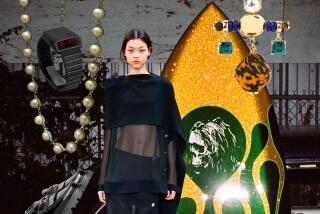And on the dainty side ...
TODAY, an apron is simply a splatter shield. But think back a generation or two to the world of black-and-white TV, when aprons bursting with color were emblems of domesticity and femininity.
They had style then.
But then it was the â60âs, and as fast as you could say âLucille Ball,â aprons plummeted out of fashion -- housewifely accouterments that came to symbolize a womanâs secondary role. These frilly, backless wraps and flirty, skirt-like cocktail numbers were blazingly incorrect.
Now, theyâre coming back through a mist of nostalgia as collectorâs items, a small part of the growing affection for vintage clothing. Hip boutiques are selling snappy little reproductions, decorated with piping, ruffles and appliqued cherries. Thereâs even an apron museum exhibit making the rounds.
Women who don an old-fashioned apron today consider it an ironic homage, a little wink at the idea of homemaking as entertainment, not duty. The reverse symbolism gives the daintiest aprons the strongest images.
Elizabeth Mason, owner of the West Hollywood vintage boutique the Paper Bag Princess, collects vintage cocktail aprons and always wears one when she entertains.
âIt identifies you as the sexy hostess,â she said. âI have one in satin that is very small. It looks as if you have a merry widow on. Imagine having that on as you greet your guests.â
It sure beats the usual utilitarian, knee-length bib that makes a party hostess look more like a waiter than a discriminating woman of style.
Masonâs boutique, where stars and costume designers shop for designer evening gowns and the like, quickly sells out of the little aprons as soon as she gets her hands on them. For those who entertain at home, they have become a must-have accessory for the vintage dress.
As Mason said: âWhat else are you going to do? Wear a denim shirt like Martha Stewart?â
Itâs not hard to see why the old aprons are in demand: Modern manufacturers wouldnât dare produce anything so charmingly politically incorrect as the ones from the 1940s and â50s. With their wine-guzzling pink elephant decorations and frilly trims, the decorative cocktail styles speak of an era when women were defined by their domestic roles and how well they mixed a martini.
More practical, neck-to-knee kitchen aprons in such folksy prints as calico and gingham also flourished in the postwar years. Like banners promoting homemaking, they were lavished with crafty embroidery and such sentimental symbols as kittens, babies and flower baskets. Often as beloved as a baby blanket, many have met undignified ends in the 25-cent bin at thrift stores.
Vintage complement
Time softens many memories, good and bad. Itâs hard to take seriously a â50s apronâs implication of servitude and oppression when it features frolicking puppies or bubbling champagne glasses. The very idea of a fancy apron worn just for serving cocktails seems ludicrous -- and thus incredibly compelling for those who would rather dress the part than actually be the part.
Cocktail aprons summon glamour, not grits, and werenât created for protection, said Mason.
âThey were made out of tulle and were completely porous, and anything you spilled on them would go directly onto the dress,â she said.
The same aesthetic reasons that motivate many women to collect antiques or wear vintage clothing attract them to aprons, said Kathleen Schaaf, owner of Meow, a Long Beach vintage clothing store.
âA lot more of the vintage collectors are entertaining at home,â she said. âThey have their Bakelite-handle silverware, Bauer pottery and their stainless-steel barware sets. Iâve seen women wearing a little hostess apron over her vintage dress.â The aprons simply complete, and improve, the picture.
When sheâs lucky, Schaaf may come across an apron that matches a tablecloth, or one that is in pristine condition because it was worn for a single Christmas dinner. Even the best examples are still affordable, however. At her boutique and on eBay, the Internet auction Web site, most vintage aprons can be had for less than $20. Some of Masonâs most exceptional examples command prices of $125, even up to $200, and are sold before they hit the showroom floor.
In the world of collectibles, aprons remain a relative bargain. Last week on eBay, a set of 16 vintage aprons was selling for $33 after 15 bids. âTheyâre highly collectible,â said eBay spokesman Jim Griffith, âbut they are one of these areas of collecting thatâs still affordable. If youâre into collecting and looking for a field, itâs probably a good time to be into it.â
In 15 years of collecting, Pasadena photographer Ramona Rosales has paid no more than $15 for any of her vintage aprons. She wears various styles for cooking, cocktail parties, baby showers, and the most tattered ones for handling chemicals in the darkroom. Her passion for them isnât rooted in practicality, however.
âIâve always worn vintage clothes,â she said. âWhen you get dressed up in a particular era, itâs the perfect finishing accessory.â
Although sheâs been known to host cocktail parties and dress the part of the â50s hostess in an elegant apron, her favorites are homemade. âThose have the best character because they have some funny little detail,â Rosales said.
The handwork skills may be vanishing, but the vintage apron is beginning to resurface. Anthropologie, the retailer of retro clothing and housewares, recently introduced reproductions of full- and half-length vintage aprons. With themes ranging from the barnyard to the hacienda, the $28 to $38 Anthropologie aprons were conceived as part of the trend for entertaining at home, said Polly Dickens, the chainâs home furnishings design director.
For some fans, however, aprons are a telling part of womenâs history. Author and collector Joyce Cheney has lent some of her 300-plus apron collection to a traveling museum show called Apron Strings: Ties to the Past.
As it toured the South and East (no dates are set for California), the exhibit of vintage and contemporary aprons helped stimulate new interest in aprons, their artwork and their meanings. A Lansing, Mich., museum encouraged members of the public to display aprons and the stories they recalled. Cheneyâs 2000 book, âAprons: Icons of the American Home,â helped document the influence of a once-common, now rarer, element of popular culture.
âMany people under 40 probably donât have any relatives who wore aprons,â Cheney said. âTo them, theyâve just become historical artifacts.â Although many historians point to the womenâs movement of the 1970s as the end of the apron and its symbolic link to womenâs oppression, Cheney found other culprits.
âAfter the â50s, people started to get washers and dryers,â she said. âSo the practical reason to protect clothes vanished some.â Cloth and ready-made clothing prices became cheaper, which reduced the need to cover precious clothing.
âA little bit of civilityâ
Still, the apron remains a powerful symbol of femininity. As Cheney noted, when cartoon animals need a gender, animators give the male a bow tie and the female an apron. And when world champion mountain biker Jacquie Phelan of Marin County wants to emphasize that finesse, not brute strength, is part of her sport, sheâll wear an apron, the most outrageous, frilly, girlie one she can find.
âThe beauty of wearing an apron on a bike is you can twist it around to cover your rear end so it gets the mud and not your precious cycling clothing,â said Phelan. âItâs a removable, washable mudflap.â
When she wears it during an annual, overwhelmingly male Thanksgiving Day ride, the apron becomes a statement about how women havenât abandoned the womanly kitchen while they also embrace the manly world of competition. Once the riders reach their destination, Phelan, who founded the Womenâs Mountain Bike & Tea Society, unpacks her Thermos of hot tea, twists the muddy apron around to the front and starts pouring.
Properly.
âThere you are,â she said, âa little bit of civility in a muddy, mountain field.â
All that and portable too.






